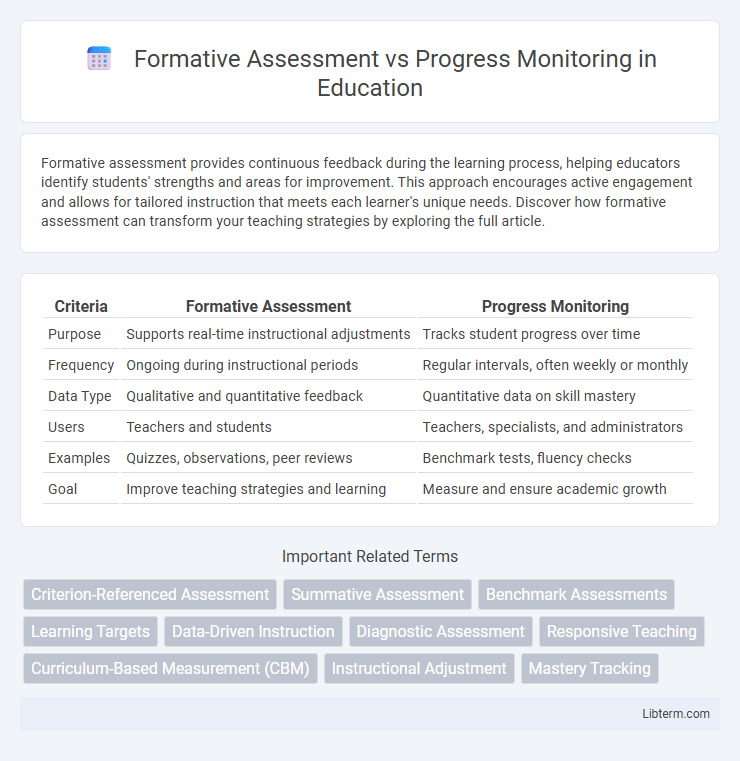Formative assessment provides continuous feedback during the learning process, helping educators identify students' strengths and areas for improvement. This approach encourages active engagement and allows for tailored instruction that meets each learner's unique needs. Discover how formative assessment can transform your teaching strategies by exploring the full article.
Table of Comparison
| Criteria | Formative Assessment | Progress Monitoring |
|---|---|---|
| Purpose | Supports real-time instructional adjustments | Tracks student progress over time |
| Frequency | Ongoing during instructional periods | Regular intervals, often weekly or monthly |
| Data Type | Qualitative and quantitative feedback | Quantitative data on skill mastery |
| Users | Teachers and students | Teachers, specialists, and administrators |
| Examples | Quizzes, observations, peer reviews | Benchmark tests, fluency checks |
| Goal | Improve teaching strategies and learning | Measure and ensure academic growth |
Introduction to Formative Assessment and Progress Monitoring
Formative assessment involves ongoing evaluations during instruction to provide immediate feedback that guides both teaching and student learning, enhancing understanding and skill development. Progress monitoring systematically tracks student performance over time using standardized measures to ensure that interventions are effective and learning goals are being met. Both methods are critical in data-driven educational practices, supporting differentiated instruction and improving student outcomes.
Defining Formative Assessment
Formative assessment is an ongoing process used by educators to evaluate student learning and provide immediate feedback to improve academic performance. It involves diverse techniques such as quizzes, observations, and discussions that inform instruction and support student growth. This approach contrasts with progress monitoring, which systematically tracks student achievement over time to measure response to interventions.
Understanding Progress Monitoring
Progress monitoring is a systematic approach that involves regularly assessing student performance to track progress toward specific learning goals, using tools like curriculum-based measurements and data analysis over time. Unlike formative assessment, which provides immediate feedback to inform instructional adjustments during a lesson or unit, progress monitoring emphasizes longitudinal data collection to gauge the effectiveness of interventions and guide overall instructional planning. This continuous data-driven process is essential for identifying students needing additional support and measuring growth in response to targeted interventions.
Key Differences between Formative Assessment and Progress Monitoring
Formative assessment focuses on gathering real-time feedback during instruction to adjust teaching strategies and improve student learning, while progress monitoring systematically tracks student performance over time to evaluate mastery and guide interventions. Formative assessments are typically informal, embedded in daily classroom activities, whereas progress monitoring uses standardized tools and frequent measurements to quantify academic growth. The key difference lies in their purpose: formative assessment informs immediate instructional decisions, and progress monitoring supports long-term progress tracking and response to intervention planning.
Purposes and Objectives of Each Approach
Formative assessment aims to provide ongoing feedback during the learning process to identify student strengths and areas for improvement, guiding instructional adjustments. Progress monitoring systematically tracks students' academic performance over time to evaluate the effectiveness of interventions and ensure they meet targeted outcomes. Both approaches focus on supporting student learning but differ in scale and frequency, with formative assessments being more immediate and formative, while progress monitoring emphasizes long-term performance trends.
Tools and Techniques for Formative Assessment
Formative assessment tools include quizzes, exit tickets, peer reviews, and interactive polling software such as Kahoot and Socrative, which provide immediate feedback to guide instructional adjustments. Techniques like observational checklists, think-aloud protocols, and concept mapping enable educators to gauge student understanding in real-time. These tools and techniques facilitate continuous feedback cycles, enhancing student engagement and targeted learning interventions.
Methods and Strategies for Progress Monitoring
Progress monitoring uses frequent, data-driven methods such as curriculum-based measurement, probe assessments, and observational checklists to systematically track student performance over time. Strategies include setting specific, measurable goals, analyzing trends through graphs or data management systems, and adjusting instruction based on real-time student progress. This continuous feedback loop ensures targeted interventions and personalized learning pathways that improve academic outcomes.
Benefits of Formative Assessment in the Classroom
Formative assessment enhances student learning by providing real-time feedback, allowing teachers to tailor instruction to individual needs and promote mastery of concepts. It fosters a supportive classroom environment where students actively engage in self-assessment and reflection, boosting motivation and ownership of learning. Frequent formative assessments help identify gaps early, increasing the effectiveness of interventions and improving overall academic outcomes.
Advantages of Progress Monitoring for Student Growth
Progress monitoring provides real-time data that enables educators to tailor instruction to individual student needs, enhancing personalized learning experiences. Frequent assessment intervals help identify learning gaps early, allowing for timely interventions that promote continuous academic growth. This systematic approach supports goal setting, tracks student progress accurately, and informs instructional adjustments to maximize student achievement.
Choosing the Right Method: Formative Assessment vs Progress Monitoring
Choosing the right method between formative assessment and progress monitoring depends on the educational goals and context. Formative assessment provides ongoing feedback during instruction to inform teaching strategies and improve student learning in real-time. Progress monitoring tracks students' academic performance over time, enabling targeted interventions and measuring growth toward long-term goals.
Formative Assessment Infographic

 libterm.com
libterm.com